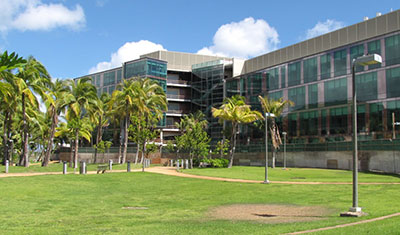
University of Hawaiʻi Cancer Center researchers have found that southern Nevada counties, including Las Vegas, show high proportions of women and younger residents coming down with a rare and aggressive cancer more commonly found in older men occupationally exposed to asbestos. This suggests that naturally occurring mineral fibers in that region are a contributing source of the cancers.
The findings, “The presence of asbestos in the natural environment is likely related to mesothelioma in young individuals and women from Southern Nevada,” published in the Journal of Thoracic Oncology highlight the need for more research to guide development in the region, where construction growth, a dry climate, dust storms and the use of off-road recreation vehicles help to make the carcinogenic fibers airborne and breathable by people. These conditions greatly increase the potential for naturally occurring asbestos to be blown into the Las Vegas Basin and cause human exposure. Once in the lungs, the fibrous particles cause problems that over time can lead to mesothelioma, a cancer of the organ lining that is aggressive and highly fatal.
“It is important to know where asbestos is in the environment so that future urban development does not encroach on it and we can prevent cancer in the future,” said UH Cancer Center Professor Michele Carbone, one of the study authors. “We have made similar discoveries in North Dakota, Turkey and New Caledonia, and we have worked with the local authorities in those locations to remedy the problem to prevent diseases in the future. We hope to do the same in Nevada.”
Working with collaborators, Francine Baumann, an assistant professor in the UH Cancer Center’s epidemiology program looked at proportions of people 55 and younger, as well as women, among mesothelioma deaths in Clark and Nye counties in southern Nevada.
Because there is a time lag of several decades from exposure to development of mesothelioma in workers occupationally exposed to asbestos, the disease occurs late in life, around 74 years of age. Instead, the University of Hawaiʻi study found higher than expected proportions of women and people younger than 55 dying from mesothelioma in southern Nevada. In some cases the individuals were younger than 20, suggesting that the exposure to asbestos occurred early in life, probably as a result of exposure to asbestos in the environment.
Baumann analyzed data from the Centers for Disease Control in the United States from 1999 through 2010 by gender, age group and county, which included a total of 31,526 malignant mesothelioma deaths.
The study found that some of the known sources of carcinogenic fibrous minerals in Nevada occur in unpopulated areas in north and central portions of the state, others near the Las Vegas metropolitan area. The Las Vegas metropolitan area has 1.9 million people either in direct contact with naturally occurring asbestos or residing in areas that for part of the year are downwind from naturally occurring asbestos sources. Portions of the Las Vegas metropolitan area have the regulated asbestos mineral actinolite, as well as other naturally occurring asbestos-like fibrous materials present in rock, soil and air.
The researchers said further study is needed to inform strategies that would minimize exposure to humans living in these areas.

